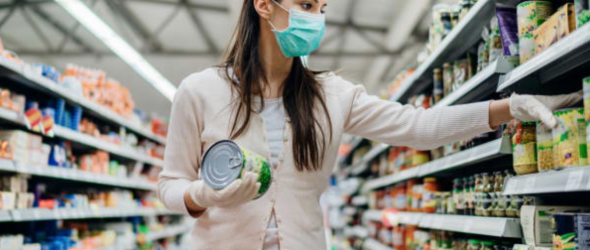Grocery chain Giant Eagle turned one of its stores into a checkout-less shopping experience. A handful of Price Chopper stores in Missouri are offering shoppers access to an app that can scan items and tally up their order, allowing them to skip the checkout line. Wegmans piloted a self-checkout app at three stores prior to the pandemic, but rolled it out to 80 of its 103 stores this spring, as customers sought out contactless shopping.
The rapid shift to online grocery ordering during the pandemic has ushered in the next phase of grocery shopping. But grocers are investing in technology meant for stores, too. They’re launching innovative technology inside brick-and-mortar locations, where the bulk of consumers still shop. Even Walmart’s new membership program, Walmart+, will offer access to a tech-based perk: a smartphone app that lets customers skip the line at stores.
Before the pandemic, nearly 98% of U.S. grocery sales were in the stores, according to McKinsey & Company. Even with the gains in curbside pickup and home delivery, 85% of sales were still in stores at the peak of Covid-19, the firm found.
Many legacy grocers have held back on rolling out or promoting flashy technology. The investments could be hard to justify in a notoriously low-margin business — especially when it’s unclear if customers will download smartphone apps or embrace innovation.

With the coronavirus pandemic, however, tech-based approaches that promote safety and speed are becoming table stakes for grocers. Customers of all ages have been more willing than before to download apps, try out services like curbside pickup and seek out ways to avoid interactions with cashiers or other customers.
Even before the pandemic, legacy grocers were getting pushed in that direction by a relatively new rival: Amazon. Known for its dominance in e-commerce, Amazon has been a smaller player in the grocery space. It owns Whole Foods, and is the ninth largest U.S. grocer with 2.2% of market share in 2019, according to data from UBS.
Walmart is the largest, with about 21% of market share last year. It’s followed by Kroger, which had about 10%.
Yet even as a smaller player, Amazon has been an ambitious one. It has rapidly expanded its physical grocery footprint to include dozens of cashierless Amazon Go stores, a new chain of Amazon Fresh grocery stores and hundreds of Whole Foods locations. It’s shaken up the ways in which consumers shop, pay for and receive their groceries. The company opened its first Whole Foods “dark store” during the pandemic to quickly pick and pack online orders. It has a service that delivers groceries to shoppers’ cars called Amazon Fresh Pickup. And most recently, it has rolled out smart shopping carts, called Dash Carts, that automatically track a customer’s order.
With the innovative grocery concepts, Amazon wants to delight customers and remove pain points in their shopping experience — and ultimately, win more business.
Sucharita Kodali, a retail analyst for Forrester, however, said legacy grocers have had good reason to hesitate on making similar investments. She said some of them increase long-term costs and create more work for the retailer. That drives down their profits.
That’s why she’s skeptical other grocers will automatically rip off each of Amazon’s additions, such as its smart grocery carts.
“They have to see an ROI first,” she said. “It would just be to keep up with the Joneses.”
Consumers’ changing preferences during the coronavirus pandemic have given grocers another reason to experiment and in some cases, take a page from the tech giant’s playbook.
Even as foot traffic has picked up at grocery stores again, many consumers say safety is still a top concern. Market research firm Ipsos polled 2,000 consumers in June and found 62% of them would stop shopping at a retailer not taking health and safety seriously.
That’s accelerated demand for technologies that can allow consumers to shop safely in stores and limit interactions with employees or other customers.
Skipping the checkout line
Giant Eagle was founded in 1931, but CEO Laura Karet said the Pittsburgh-based private grocer has kept an eye on innovation. She said it’s monitored developments in Asia and Europe, where grocery shoppers have been quicker to adopt contactless payments and online grocery shopping.
That inspired a deal with Grabango, a California-based start-up that’s retrofitted one of Giant Eagle’s GetGo convenience stores. The stores average 6,000 square feet. Starting this month, shoppers can walk into the store, pick out snacks or fill up a soda and leave without checking out.
The technology in the retrofitted store resembles that of Amazon Go. Shoppers download an app, where they add payment information. They get a QR-code to scan at the store.
